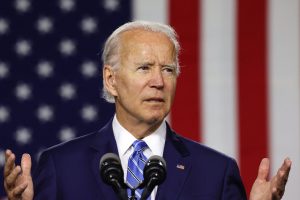
US President, Joe Bidden
The cost of everything needed for China’s post-pandemic infrastructure boom, from steel and coal to glass and cement, is soaring. The price of rebar, a type of steel used to reinforce concrete, recently hit 6,200 yuan ($965) per metric ton in Shanghai, up 40% this year, and a new record high. Iron ore, which is used to make steel, has topped 1,240 yuan per metric ton ($194) on the Dalian Futures Exchange, a 25% increase since the start of the year.
Thermal coal, glass and aluminum are hitting all-time highs in China. The price of plasterboard is rising too. The situation with steel has become so acute that China’s leaders are warning of damage to the economy. And a popular idiom for defenseless — “without an inch of steel in hand” — is now being used much more literally on social media to describe desperate buyers.
Construction is also part of the economic recovery in the United States, and may accelerate soon. President Joe Biden proposed in March a roughly $2 trillion infrastructure plan aimed at helping the nation recover from the coronavirus pandemic, and reshaping the US economy to counter China’s rise. Washington has challenges to contend with, such as aging, vulnerable infrastructure that is part of the country’s critical systems, and politics that might cause Biden’s plan to stall in Congress.
But China has reasons to worry about the skyrocketing costs, too. China’s producer price index, which measures the change in costs that manufacturers pay for materials, rose 6.8% in April from a year earlier. While that’s somewhat distorted, given the impact of the Covid-19 pandemic shutdown in 2020, it’s still the fastest surge since October 2017. It’s also a big jump over March’s 4.4% increase.
“Global commodity prices are rising because stimulus by major economies are pushing up the demand,” said Zhou Hao, a senior emerging markets economist for Commerzbank, who added that “the United States and China are both the drivers.”
Prices for many of the base metals, including aluminum and copper, have climbed to multi-year highs on the London Metal Exchange. The Bloomberg Commodity Index, which tracks a diversified basket of commodity futures, is hovering around the highest level in six years.
Expensive construction projects are already pushing some Chinese companies to suspend work, according to recent survey data. And analysts warn that as smaller businesses weigh whether to cut costs or scale down, they could start shedding workers.
“Small businesses are facing even tighter cash flows, because they have less negotiation power when prices increase in their upstream sector,” wrote Luo Zhiheng, chief macro analyst for Guangzhou-based Yuekai Securities. “They either have to accept higher production costs, or cut their production and sit on the sidelines.”
The spike in steel and iron ore prices comes down to a combination of factors. Along with construction, electric vehicle production is also fueling the rise, according to analysts at Fitch Ratings. Cars need high-strength steel that can reduce weight and improve performance, and production of electric, hybrid and fuel cell cars have been skyrocketing.
China’s efforts to reduce carbon emissions has also caused steel supply to tighten, the analysts wrote in a report this week. China produced more than half of the world’s output of steel last year, and Beijing has been pressuring the industry to reduce output in pursuit of its goal to become carbon neutral by 2060.
A bruising trade battle between China and Australia may also be inflating prices. Beijing has put up barriers to entry on several Australian exports over the last year, including coal. While one of Canberra’s most important exports, iron ore, has been spared, Beijing has been looking for ways to reduce its reliance on the country.
There are already some signs that the price hikes are hitting China’s construction sites and factories, according to Wang Jiechao, chief construction sector analyst for Pacific Securities. He wrote in a Monday report that many construction companies, foundries and small household appliance manufacturers have stopped taking orders because of production losses.
“The rapid increase in commodity prices has seriously eroded the profitability of downstream manufacturing companies,” Wang added.
A recent survey of 460 construction companies nationwide revealed that many firms are feeling the pinch. Some 56% of respondents to the survey — conducted by 100njz.com, a Chinese construction industry data provider — said that the price hikes have affected their work schedules to varying degrees. Among them, 30% said they have suspend construction to control costs, while the rest have slowed projects down.
Meanwhile, 44% of the respondents to that survey said that although they are still moving ahead with construction as planned, they have had to reduce their steel purchases, which could lead them to consider suspending work in the future.
It’s also bad news for employment, according to Luo of Yuekai Securities, who noted that small businesses are struggling with the price hikes and also account for 80% of the country’s urban jobs.
Luo pointed out that April’s unemployment rate for young people aged 16 to 24 remained high at nearly 14% and their working hours decreased, “possibly because small businesses were running below capacity under the pressure of rising costs.”
Concern in Beijing
Leaders in Beijing are starting to show concern about the rising costs and how they could weigh on the economic recovery.
Chinese Premier Li Keqiang has repeatedly mentioned “rising commodity prices” and the pressures on small businesses during recent state meetings, according to the central government’s official website.
“We must … deal with the excessively rapid increase in commodity prices and its collateral effects,” Li told the State Council at its executive meeting last Wednesday. He added that such efforts were needed to “keep the economy running smoothly.”
The stakes are high. China needs to grow a bit less than 5% each year through the next decade to hit President Xi Jinping’s goal to double GDP by 2035. The government has targeted growth of 6% or above this year, and also wants to add 11 million new jobs.
But anything that threatens its fragile economic recovery could pose risks to those ambitions — something authorities have noted.
Li, for example, said last month during a meeting with business executives that ensuring employment is the “key foundation for stabilizing the economy,” adding that the government would try to help curb the cost of raw materials.
China is still exporting a lot steel, but the government is starting to discourage that in a bid to shore up supply at home. Authorities announced in April that starting this month, they would end export tax rebates for most of the steel products. Customs officials have also cut import tariffs for some steel.
Local governments, meanwhile, have opted for harsh measures in a bid to keep prices down. Late last week, regulators in Shanghai and the steelmaking hub Tangshan summoned major steel mills and ordered them to fix their prices “at reasonable levels.” Mills could face “severe punishments” if they collude to drive up steel prices, according to government statements.
Major futures exchanges in Shanghai, Dalian, and Zhengzhou have also tightened trading rules for steel or coal contracts, and have raised trading fees to cool down the market. Three top coal index compilers even stopped publishing daily updates. The move was to “stabilize market prices,” the state-backed China Coal Transportation and Distribution Association, one of the index compilers, said last week.
Still, prices for the metals remain elevated. And some analysts have pointed out that it will be tough for China to reign in commodity prices without compromising elsewhere.
Beijing “could easily run out of options” to contain inflation unless it walks back other goals, such as its climate targets, Citi analysts wrote in a Monday research report. They added that they don’t expect Beijing to abandon its environmental agenda, which has a “higher political priority” than inflation risks.
What the rising prices have exposed, according to Louis Kuijs of Oxford Economics, is how reliant China is on its infrastructure plan to steady the economy — and how difficult it may be to change course.
“China’s economy performed well in the initial stages of the recovery from Covid-19, benefiting from infrastructure-oriented stimulus and strong real estate activity and exports,” said Kuijs, the firm’s head of Asia economics.
“The big question in China is whether this year growth can rotate away from infrastructure and real estate to corporate investment and consumption.”
– cnn.com


